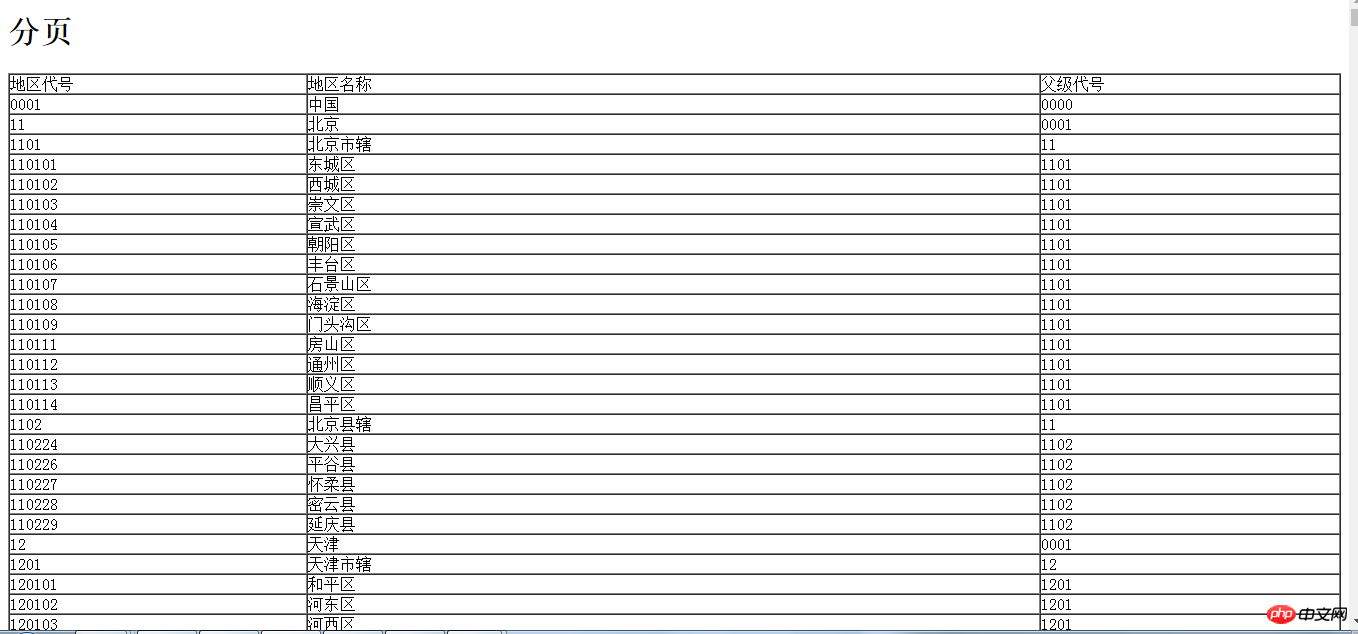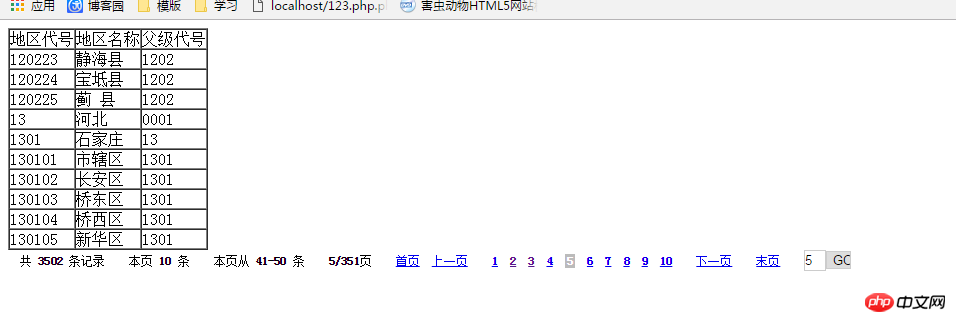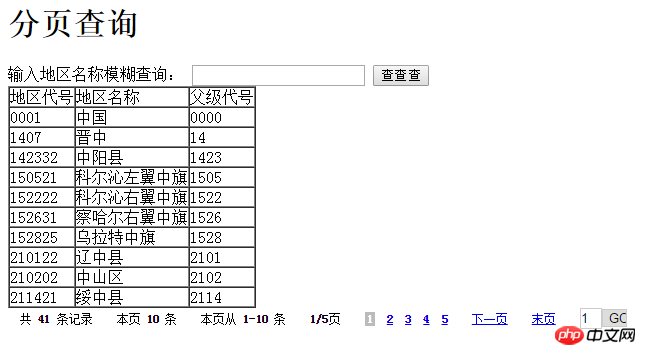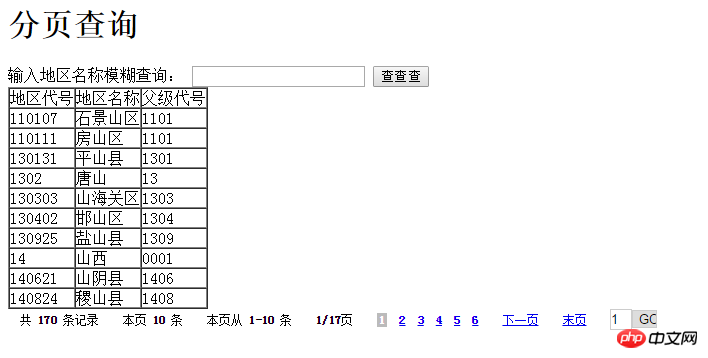php分页查询 - 附php分页代码
php分页查询通过引用page.class.php分页工具,就好写多了;
以下就是php分页代码
1.首先要有显示的内容:
<!DOCTYPE html PUBLIC "-//W3C//DTD XHTML 1.0 Transitional//EN" "http://www.w3.org/TR/xhtml1/DTD/xhtml1-transitional.dtd"> <html xmlns="http://www.w3.org/1999/xhtml"> <head> <meta http-equiv="Content-Type" content="text/html; charset=utf-8" /> <title>无标题文档</title> </head> <body> <h1>分页</h1> <table width="100%" border="1" cellpadding="0" cellspacing="0"> <tr> <td>地区代号</td> <td>地区名称</td> <td>父级代号</td> </tr>
<?php
include ("db.class.php");
$db = new db();
$sql = "select * from chinastates ";
$arr = $db->Query($sql);//默认=1可以不写
foreach($arr as $v)
{
echo "<tr>
<td>{$v[0]}</td>
<td>{$v[1]}</td>
<td>{$v[2]}</td>
</tr>";
}
?>
</table> </body>
图:

2.引用page.class.php分页工具造对象,把总数查出来吧:
include ("page.class.php");
//查总条数
$sz = "select count(*) from chinastates";
$az = $db->Query($sz);
//1.造对象
$page = new page($az[0][0],10);
//一般只写两个参数,第一个数据的总条数
//取两个索引0:先取索引0二维数组,取到一位数组后取索引0
//第二个参数,显示10条
$sql = "select * from chinastates ".$page->limit;
//2.直接在sql语句后面拼接上$page(分页类)里面的limit,就可以完成分页
$arr = $db->Query($sql);//默认=1可以不写
3.输出:
<?php //3.输出分页信息 echo $page->fpage(); //分页对象中的fpage()方法 ?>
总代码:
<!DOCTYPE html PUBLIC "-//W3C//DTD XHTML 1.0 Transitional//EN" "http://www.w3.org/TR/xhtml1/DTD/xhtml1-transitional.dtd">
<html xmlns="http://www.w3.org/1999/xhtml">
<head>
<title>无标题文档</title>
</head>
<body>
<h1>分页查询</h1>
<table border="1" cellpadding="0" cellspacing="0">
<tr>
<td>地区代号</td>
<td>地区名称</td>
<td>父级代号</td>
</tr>
<?php
include ("DBDA.class.php");
//引用封装类
$db = new db();
//造对象
include "page.class.php";
//引用page工具
$aall = "select count(*) from chinastates";
//查询所有数据
$arr = $db->Query($aall);
//调用sql,返回一个数组,
$page = new page($arr[0][0],10);
//page类对象,每页显示10条
$sql = "select * from chinastates ".$page->limit;
//分页查询,page类调用limit
$ar = $db->Query($sql);
//执行,并返回一个数组(数据)
foreach ($ar as $v)
//遍历
{
echo" <tr>
<td>{$v[0]}</td>
<td>{$v[1]}</td>
<td>{$v[2]}</td>
</tr>
";
}
//显示
?>
</table>
<p>
<?php
echo $page->fpage();
//直接输出page类里面的fpage()(输出分页信息)
?>
</p>
</body>
</html>
最后的完成图:

4.分页查询
查询关键字,在本页分页显示!
首先form表单:
<form action="fenyechaxun.php" method="get"> //提交给当前页面,用get传递 <p> 输入地区名称模糊查询: <input type="text" name="area"/> <input type="submit" value="查查查"/> </p> </form>
分页查询的条件
$tj = "1 = 1 ";
//条件恒变量
if(!empty($_GET["area"]))
//判断传过来的是否非空
{
$r = $_GET["area"];
//为了防止双引号有冲突,给变量
$tj = "areaname like '%{$r}%' ";
//条件改变
}
查询语句也需要改变一下:
$aall = "select count(*) from chinastates WHERE {$tj}";
//查询所有数据
$sql = "select * from chinastates WHERE {$tj} ".$page->limit;
//分页查询,page类调用limit输出:
<p>
<?php
echo $page->fpage();
//直接输出page类里面的fpage()(输出分页信息)
?>
</p>
上图:

查询的数据也是以分页的形式:

代码:
分页查询
| 地区代号 | 地区名称 | 父级代号 |
| {$v[0]} | {$v[1]} | {$v[2]} |
echo $page->fpage();
//直接输出page类里面的fpage()(输出分页信息)
?>
page.class.php分页工具
/**
file: page.class.php
完美分页类 Page
*/
class Page {
private $total; //数据表中总记录数
private $listRows; //每页显示行数
private $limit; //SQL语句使用limit从句,限制获取记录个数,查数据要查哪几条;limit(0,10)跳过第0条,取10条
private $uri; //自动获取url的请求地址
private $pageNum; //总页数
private $page; //当前页
private $config = array(
'head' => "条记录",
'prev' => "上一页",
'next' => "下一页",
'first'=> "首页",
'last' => "末页"
);
//可以修改的信息
//在分页信息中显示内容,可以自己通过set()方法设置
private $listNum = 10; //默认分页列表显示的个数,下面列表要显示多少条,10个
/**
构造方法,可以设置分页类的属性
@param int $total 计算分页的总记录数
@param int $listRows 可选的,设置每页需要显示的记录数,默认为25条
@param mixed $query 可选的,为向目标页面传递参数,可以是数组,也可以是查询字符串格式
@param bool $ord 可选的,默认值为true, 页面从第一页开始显示,false则为最后一页
*/
public function __construct($total, $listRows=25, $query="", $ord=true){
$this->total = $total;
$this->listRows = $listRows;
$this->uri = $this->getUri($query);
//自动获取游览器地址
$this->pageNum = ceil($this->total / $this->listRows);//(总共多少条数据/每页显示几条)ceil:向上取整
//取成员变量,$ord=ture首页
/*以下判断用来设置当前面*/
//去当前页
if(!empty($_GET["page"])) {
$page = $_GET["page"];
}else{
if($ord)
$page = 1;
else
$page = $this->pageNum;
}
if($total > 0) {
if(preg_match('/\D/', $page) ){
$this->page = 1;
}else{
$this->page = $page;
}
}else{
$this->page = 0;
}
$this->limit = "LIMIT ".$this->setLimit();
//LIMIT 10,10
}
/**
用于设置显示分页的信息,可以进行连贯操作
@param string $param 是成员属性数组config的下标
@param string $value 用于设置config下标对应的元素值
@return object 返回本对象自己$this, 用于连惯操作
*/
function set($param, $value){
if(array_key_exists($param, $this->config)){
$this->config[$param] = $value;
}
return $this;
}
/* 不是直接去调用,通过该方法,可以使用在对象外部直接获取私有成员属性limit和page的值 */
function __get($args){
if($args == "limit" || $args == "page")
return $this->$args;
else
return null;
}
/**
按指定的格式输出分页
@param int 0-7的数字分别作为参数,用于自定义输出分页结构和调整结构的顺序,默认输出全部结构
@return string 分页信息内容
*/
function fpage(){
$arr = func_get_args(); //用户参数
$html[0] = " 共 {$this->total} {$this->config["head"]} ";
$html[1] = " 本页 ".$this->disnum()." 条 ";
$html[2] = " 本页从 {$this->start()}-{$this->end()} 条 ";
$html[3] = " {$this->page}/{$this->pageNum}页 ";
$html[4] = $this->firstprev();
$html[5] = $this->pageList();
$html[6] = $this->nextlast();
$html[7] = $this->goPage();
$fpage = '
';
if(count($arr) < 1)
$arr = array(0, 1,2,3,4,5,6,7);
for($i = 0; $i < count($arr); $i++)
$fpage .= $html[$arr[$i]];
$fpage .= '
return $fpage;
}
/* 在对象内部使用的私有方法,*/
private function setLimit(){
if($this->page > 0)
return ($this->page-1)*$this->listRows.", {$this->listRows}";
else
return 0;
}
/* 在对象内部使用的私有方法,用于自动获取访问的当前URL */
private function getUri($query){
$request_uri = $_SERVER["REQUEST_URI"];
$url = strstr($request_uri,'?') ? $request_uri : $request_uri.'?';
if(is_array($query))
$url .= http_build_query($query);
else if($query != "")
$url .= "&".trim($query, "?&");
$arr = parse_url($url);
if(isset($arr["query"])){
parse_str($arr["query"], $arrs);
unset($arrs["page"]);
$url = $arr["path"].'?'.http_build_query($arrs);
}
if(strstr($url, '?')) {
if(substr($url, -1)!='?')
$url = $url.'&';
}else{
$url = $url.'?';
}
return $url;
}
/* 在对象内部使用的私有方法,用于获取当前页开始的记录数 */
private function start(){
if($this->total == 0)
return 0;
else
return ($this->page-1) * $this->listRows+1;
}
/* 在对象内部使用的私有方法,用于获取当前页结束的记录数 */
private function end(){
return min($this->page * $this->listRows, $this->total);
}
/* 在对象内部使用的私有方法,用于获取上一页和首页的操作信息 */
private function firstprev(){
if($this->page > 1) {
$str = " uri}page=1'>{$this->config["first"]} ";
$str .= "uri}page=".($this->page-1)."'>{$this->config["prev"]} ";
return $str;
}
}
/* 在对象内部使用的私有方法,用于获取页数列表信息 */
private function pageList(){
$linkPage = " ";
$inum = floor($this->listNum/2);
/*当前页前面的列表 */
for($i = $inum; $i >= 1; $i--){
$page = $this->page-$i;
if($page >= 1)
$linkPage .= "uri}page={$page}'>{$page} ";
}
/*当前页的信息 */
if($this->pageNum > 1)
$linkPage .= "{$this->page} ";
/*当前页后面的列表 */
for($i=1; $i <= $inum; $i++){
$page = $this->page+$i;
if($page <= $this->pageNum)
$linkPage .= "uri}page={$page}'>{$page} ";
else
break;
}
$linkPage .= '';
return $linkPage;
}
/* 在对象内部使用的私有方法,获取下一页和尾页的操作信息 */
private function nextlast(){
if($this->page != $this->pageNum) {
$str = " uri}page=".($this->page+1)."'>{$this->config["next"]} ";
$str .= " uri}page=".($this->pageNum)."'>{$this->config["last"]} ";
return $str;
}
}
/* 在对象内部使用的私有方法,用于显示和处理表单跳转页面 */
private function goPage(){
if($this->pageNum > 1) {
return ' ';
}
}
/* 在对象内部使用的私有方法,用于获取本页显示的记录条数 */
private function disnum(){
if($this->total > 0){
return $this->end()-$this->start()+1;
}else{
return 0;
}
}
}
1.首先要有显示的内容:
<!DOCTYPE html PUBLIC "-//W3C//DTD XHTML 1.0 Transitional//EN" "http://www.w3.org/TR/xhtml1/DTD/xhtml1-transitional.dtd"> <html xmlns="http://www.w3.org/1999/xhtml"> <head> <meta http-equiv="Content-Type" content="text/html; charset=utf-8" /> <title>无标题文档</title> </head> <body> <h1>分页</h1> <table width="100%" border="1" cellpadding="0" cellspacing="0"> <tr> <td>地区代号</td> <td>地区名称</td> <td>父级代号</td> </tr>
<?php
include ("db.class.php");
$db = new db();
$sql = "select * from chinastates ";
$arr = $db->Query($sql);//默认=1可以不写
foreach($arr as $v)
{
echo "<tr>
<td>{$v[0]}</td>
<td>{$v[1]}</td>
<td>{$v[2]}</td>
</tr>";
}
?>
</table> </body>
图:

2.引用page.class.php分页工具造对象,把总数查出来吧:
include ("page.class.php");
//查总条数
$sz = "select count(*) from chinastates";
$az = $db->Query($sz);
//1.造对象
$page = new page($az[0][0],10);
//一般只写两个参数,第一个数据的总条数
//取两个索引0:先取索引0二维数组,取到一位数组后取索引0
//第二个参数,显示10条
$sql = "select * from chinastates ".$page->limit;
//2.直接在sql语句后面拼接上$page(分页类)里面的limit,就可以完成分页
$arr = $db->Query($sql);//默认=1可以不写
3.输出:
<?php //3.输出分页信息 echo $page->fpage(); //分页对象中的fpage()方法 ?>
总代码:
<!DOCTYPE html PUBLIC "-//W3C//DTD XHTML 1.0 Transitional//EN" "http://www.w3.org/TR/xhtml1/DTD/xhtml1-transitional.dtd">
<html xmlns="http://www.w3.org/1999/xhtml">
<head>
<title>无标题文档</title>
</head>
<body>
<h1>分页查询</h1>
<table border="1" cellpadding="0" cellspacing="0">
<tr>
<td>地区代号</td>
<td>地区名称</td>
<td>父级代号</td>
</tr>
<?php
include ("DBDA.class.php");
//引用封装类
$db = new db();
//造对象
include "page.class.php";
//引用page工具
$aall = "select count(*) from chinastates";
//查询所有数据
$arr = $db->Query($aall);
//调用sql,返回一个数组,
$page = new page($arr[0][0],10);
//page类对象,每页显示10条
$sql = "select * from chinastates ".$page->limit;
//分页查询,page类调用limit
$ar = $db->Query($sql);
//执行,并返回一个数组(数据)
foreach ($ar as $v)
//遍历
{
echo" <tr>
<td>{$v[0]}</td>
<td>{$v[1]}</td>
<td>{$v[2]}</td>
</tr>
";
}
//显示
?>
</table>
<p>
<?php
echo $page->fpage();
//直接输出page类里面的fpage()(输出分页信息)
?>
</p>
</body>
</html>
最后的完成图:

4.分页查询
查询关键字,在本页分页显示!
首先form表单:
<form action="fenyechaxun.php" method="get"> //提交给当前页面,用get传递 <p> 输入地区名称模糊查询: <input type="text" name="area"/> <input type="submit" value="查查查"/> </p> </form>
分页查询的条件
$tj = "1 = 1 ";
//条件恒变量
if(!empty($_GET["area"]))
//判断传过来的是否非空
{
$r = $_GET["area"];
//为了防止双引号有冲突,给变量
$tj = "areaname like '%{$r}%' ";
//条件改变
}
查询语句也需要改变一下:
$aall = "select count(*) from chinastates WHERE {$tj}";
//查询所有数据
$sql = "select * from chinastates WHERE {$tj} ".$page->limit;
//分页查询,page类调用limit输出:
<p>
<?php
echo $page->fpage();
//直接输出page类里面的fpage()(输出分页信息)
?>
</p>
上图:

查询的数据也是以分页的形式:

代码:
分页查询
| 地区代号 | 地区名称 | 父级代号 |
| {$v[0]} | {$v[1]} | {$v[2]} |
echo $page->fpage();
//直接输出page类里面的fpage()(输出分页信息)
?>
page.class.php分页工具
/**
file: page.class.php
完美分页类 Page
*/
class Page {
private $total; //数据表中总记录数
private $listRows; //每页显示行数
private $limit; //SQL语句使用limit从句,限制获取记录个数,查数据要查哪几条;limit(0,10)跳过第0条,取10条
private $uri; //自动获取url的请求地址
private $pageNum; //总页数
private $page; //当前页
private $config = array(
'head' => "条记录",
'prev' => "上一页",
'next' => "下一页",
'first'=> "首页",
'last' => "末页"
);
//可以修改的信息
//在分页信息中显示内容,可以自己通过set()方法设置
private $listNum = 10; //默认分页列表显示的个数,下面列表要显示多少条,10个
/**
构造方法,可以设置分页类的属性
@param int $total 计算分页的总记录数
@param int $listRows 可选的,设置每页需要显示的记录数,默认为25条
@param mixed $query 可选的,为向目标页面传递参数,可以是数组,也可以是查询字符串格式
@param bool $ord 可选的,默认值为true, 页面从第一页开始显示,false则为最后一页
*/
public function __construct($total, $listRows=25, $query="", $ord=true){
$this->total = $total;
$this->listRows = $listRows;
$this->uri = $this->getUri($query);
//自动获取游览器地址
$this->pageNum = ceil($this->total / $this->listRows);//(总共多少条数据/每页显示几条)ceil:向上取整
//取成员变量,$ord=ture首页
/*以下判断用来设置当前面*/
//去当前页
if(!empty($_GET["page"])) {
$page = $_GET["page"];
}else{
if($ord)
$page = 1;
else
$page = $this->pageNum;
}
if($total > 0) {
if(preg_match('/\D/', $page) ){
$this->page = 1;
}else{
$this->page = $page;
}
}else{
$this->page = 0;
}
$this->limit = "LIMIT ".$this->setLimit();
//LIMIT 10,10
}
/**
用于设置显示分页的信息,可以进行连贯操作
@param string $param 是成员属性数组config的下标
@param string $value 用于设置config下标对应的元素值
@return object 返回本对象自己$this, 用于连惯操作
*/
function set($param, $value){
if(array_key_exists($param, $this->config)){
$this->config[$param] = $value;
}
return $this;
}
/* 不是直接去调用,通过该方法,可以使用在对象外部直接获取私有成员属性limit和page的值 */
function __get($args){
if($args == "limit" || $args == "page")
return $this->$args;
else
return null;
}
/**
按指定的格式输出分页
@param int 0-7的数字分别作为参数,用于自定义输出分页结构和调整结构的顺序,默认输出全部结构
@return string 分页信息内容
*/
function fpage(){
$arr = func_get_args(); //用户参数
$html[0] = " 共 {$this->total} {$this->config["head"]} ";
$html[1] = " 本页 ".$this->disnum()." 条 ";
$html[2] = " 本页从 {$this->start()}-{$this->end()} 条 ";
$html[3] = " {$this->page}/{$this->pageNum}页 ";
$html[4] = $this->firstprev();
$html[5] = $this->pageList();
$html[6] = $this->nextlast();
$html[7] = $this->goPage();
$fpage = '
';
if(count($arr) < 1)
$arr = array(0, 1,2,3,4,5,6,7);
for($i = 0; $i < count($arr); $i++)
$fpage .= $html[$arr[$i]];
$fpage .= '
return $fpage;
}
/* 在对象内部使用的私有方法,*/
private function setLimit(){
if($this->page > 0)
return ($this->page-1)*$this->listRows.", {$this->listRows}";
else
return 0;
}
/* 在对象内部使用的私有方法,用于自动获取访问的当前URL */
private function getUri($query){
$request_uri = $_SERVER["REQUEST_URI"];
$url = strstr($request_uri,'?') ? $request_uri : $request_uri.'?';
if(is_array($query))
$url .= http_build_query($query);
else if($query != "")
$url .= "&".trim($query, "?&");
$arr = parse_url($url);
if(isset($arr["query"])){
parse_str($arr["query"], $arrs);
unset($arrs["page"]);
$url = $arr["path"].'?'.http_build_query($arrs);
}
if(strstr($url, '?')) {
if(substr($url, -1)!='?')
$url = $url.'&';
}else{
$url = $url.'?';
}
return $url;
}
/* 在对象内部使用的私有方法,用于获取当前页开始的记录数 */
private function start(){
if($this->total == 0)
return 0;
else
return ($this->page-1) * $this->listRows+1;
}
/* 在对象内部使用的私有方法,用于获取当前页结束的记录数 */
private function end(){
return min($this->page * $this->listRows, $this->total);
}
/* 在对象内部使用的私有方法,用于获取上一页和首页的操作信息 */
private function firstprev(){
if($this->page > 1) {
$str = " uri}page=1'>{$this->config["first"]} ";
$str .= "uri}page=".($this->page-1)."'>{$this->config["prev"]} ";
return $str;
}
}
/* 在对象内部使用的私有方法,用于获取页数列表信息 */
private function pageList(){
$linkPage = " ";
$inum = floor($this->listNum/2);
/*当前页前面的列表 */
for($i = $inum; $i >= 1; $i--){
$page = $this->page-$i;
if($page >= 1)
$linkPage .= "uri}page={$page}'>{$page} ";
}
/*当前页的信息 */
if($this->pageNum > 1)
$linkPage .= "{$this->page} ";
/*当前页后面的列表 */
for($i=1; $i <= $inum; $i++){
$page = $this->page+$i;
if($page <= $this->pageNum)
$linkPage .= "uri}page={$page}'>{$page} ";
else
break;
}
$linkPage .= '';
return $linkPage;
}
/* 在对象内部使用的私有方法,获取下一页和尾页的操作信息 */
private function nextlast(){
if($this->page != $this->pageNum) {
$str = " uri}page=".($this->page+1)."'>{$this->config["next"]} ";
$str .= " uri}page=".($this->pageNum)."'>{$this->config["last"]} ";
return $str;
}
}
/* 在对象内部使用的私有方法,用于显示和处理表单跳转页面 */
private function goPage(){
if($this->pageNum > 1) {
return ' ';
}
}
/* 在对象内部使用的私有方法,用于获取本页显示的记录条数 */
private function disnum(){
if($this->total > 0){
return $this->end()-$this->start()+1;
}else{
return 0;
}
}
}
更多php分页查询 - 附php分页代码文章,请关注php中文网

Hot AI Tools

Undresser.AI Undress
AI-powered app for creating realistic nude photos

AI Clothes Remover
Online AI tool for removing clothes from photos.

Undress AI Tool
Undress images for free

Clothoff.io
AI clothes remover

Video Face Swap
Swap faces in any video effortlessly with our completely free AI face swap tool!

Hot Article

Hot Tools

Notepad++7.3.1
Easy-to-use and free code editor

SublimeText3 Chinese version
Chinese version, very easy to use

Zend Studio 13.0.1
Powerful PHP integrated development environment

Dreamweaver CS6
Visual web development tools

SublimeText3 Mac version
God-level code editing software (SublimeText3)

Hot Topics
 1669
1669
 14
14
 1428
1428
 52
52
 1329
1329
 25
25
 1273
1273
 29
29
 1256
1256
 24
24
 Explain secure password hashing in PHP (e.g., password_hash, password_verify). Why not use MD5 or SHA1?
Apr 17, 2025 am 12:06 AM
Explain secure password hashing in PHP (e.g., password_hash, password_verify). Why not use MD5 or SHA1?
Apr 17, 2025 am 12:06 AM
In PHP, password_hash and password_verify functions should be used to implement secure password hashing, and MD5 or SHA1 should not be used. 1) password_hash generates a hash containing salt values to enhance security. 2) Password_verify verify password and ensure security by comparing hash values. 3) MD5 and SHA1 are vulnerable and lack salt values, and are not suitable for modern password security.
 PHP and Python: Comparing Two Popular Programming Languages
Apr 14, 2025 am 12:13 AM
PHP and Python: Comparing Two Popular Programming Languages
Apr 14, 2025 am 12:13 AM
PHP and Python each have their own advantages, and choose according to project requirements. 1.PHP is suitable for web development, especially for rapid development and maintenance of websites. 2. Python is suitable for data science, machine learning and artificial intelligence, with concise syntax and suitable for beginners.
 PHP in Action: Real-World Examples and Applications
Apr 14, 2025 am 12:19 AM
PHP in Action: Real-World Examples and Applications
Apr 14, 2025 am 12:19 AM
PHP is widely used in e-commerce, content management systems and API development. 1) E-commerce: used for shopping cart function and payment processing. 2) Content management system: used for dynamic content generation and user management. 3) API development: used for RESTful API development and API security. Through performance optimization and best practices, the efficiency and maintainability of PHP applications are improved.
 How does PHP type hinting work, including scalar types, return types, union types, and nullable types?
Apr 17, 2025 am 12:25 AM
How does PHP type hinting work, including scalar types, return types, union types, and nullable types?
Apr 17, 2025 am 12:25 AM
PHP type prompts to improve code quality and readability. 1) Scalar type tips: Since PHP7.0, basic data types are allowed to be specified in function parameters, such as int, float, etc. 2) Return type prompt: Ensure the consistency of the function return value type. 3) Union type prompt: Since PHP8.0, multiple types are allowed to be specified in function parameters or return values. 4) Nullable type prompt: Allows to include null values and handle functions that may return null values.
 The Enduring Relevance of PHP: Is It Still Alive?
Apr 14, 2025 am 12:12 AM
The Enduring Relevance of PHP: Is It Still Alive?
Apr 14, 2025 am 12:12 AM
PHP is still dynamic and still occupies an important position in the field of modern programming. 1) PHP's simplicity and powerful community support make it widely used in web development; 2) Its flexibility and stability make it outstanding in handling web forms, database operations and file processing; 3) PHP is constantly evolving and optimizing, suitable for beginners and experienced developers.
 PHP and Python: Different Paradigms Explained
Apr 18, 2025 am 12:26 AM
PHP and Python: Different Paradigms Explained
Apr 18, 2025 am 12:26 AM
PHP is mainly procedural programming, but also supports object-oriented programming (OOP); Python supports a variety of paradigms, including OOP, functional and procedural programming. PHP is suitable for web development, and Python is suitable for a variety of applications such as data analysis and machine learning.
 How do you prevent SQL Injection in PHP? (Prepared statements, PDO)
Apr 15, 2025 am 12:15 AM
How do you prevent SQL Injection in PHP? (Prepared statements, PDO)
Apr 15, 2025 am 12:15 AM
Using preprocessing statements and PDO in PHP can effectively prevent SQL injection attacks. 1) Use PDO to connect to the database and set the error mode. 2) Create preprocessing statements through the prepare method and pass data using placeholders and execute methods. 3) Process query results and ensure the security and performance of the code.
 PHP and Python: Code Examples and Comparison
Apr 15, 2025 am 12:07 AM
PHP and Python: Code Examples and Comparison
Apr 15, 2025 am 12:07 AM
PHP and Python have their own advantages and disadvantages, and the choice depends on project needs and personal preferences. 1.PHP is suitable for rapid development and maintenance of large-scale web applications. 2. Python dominates the field of data science and machine learning.





